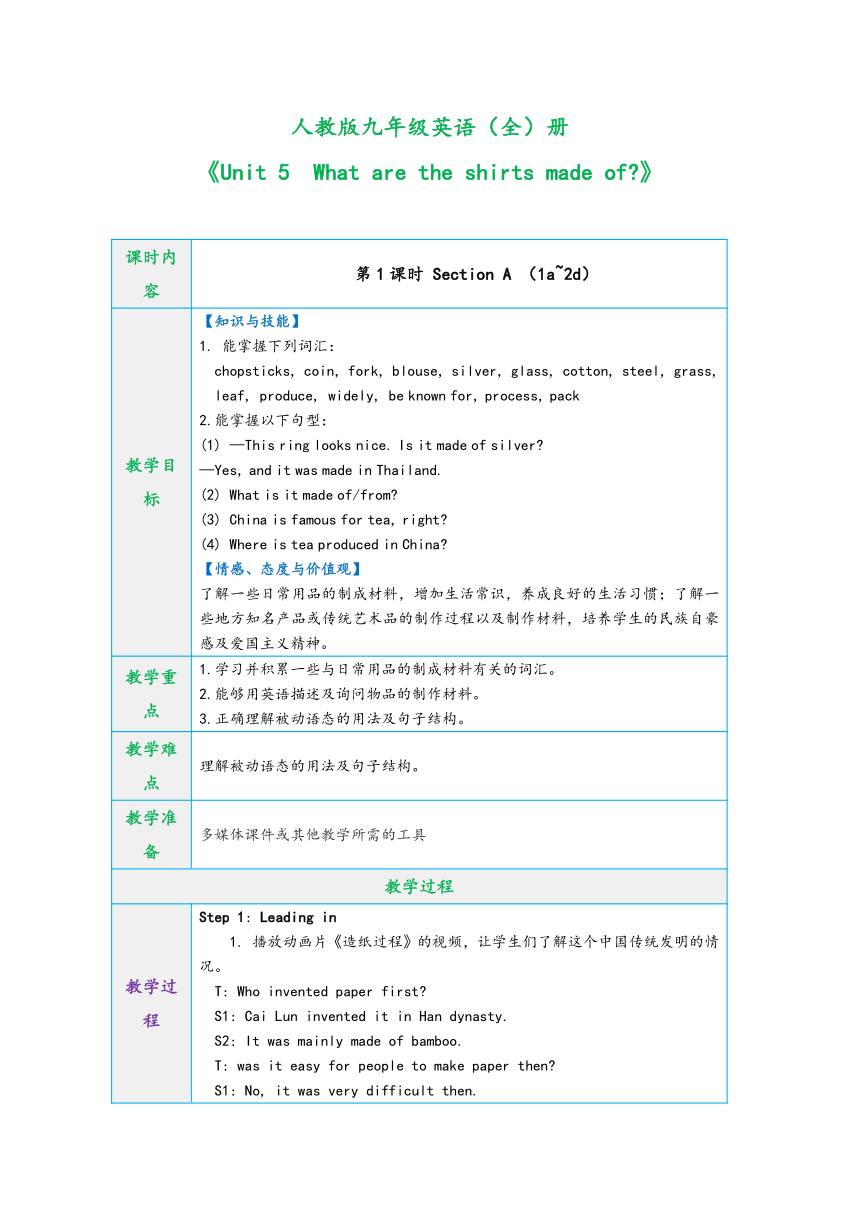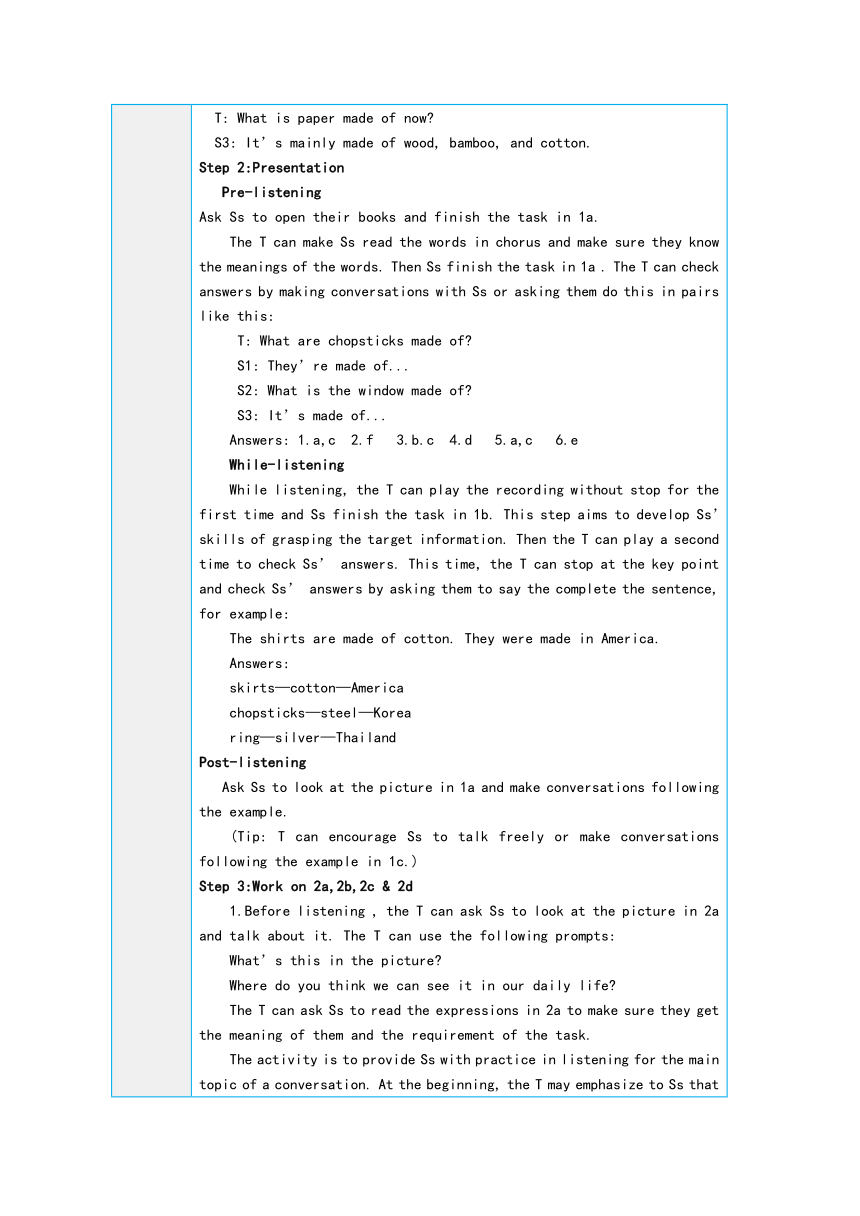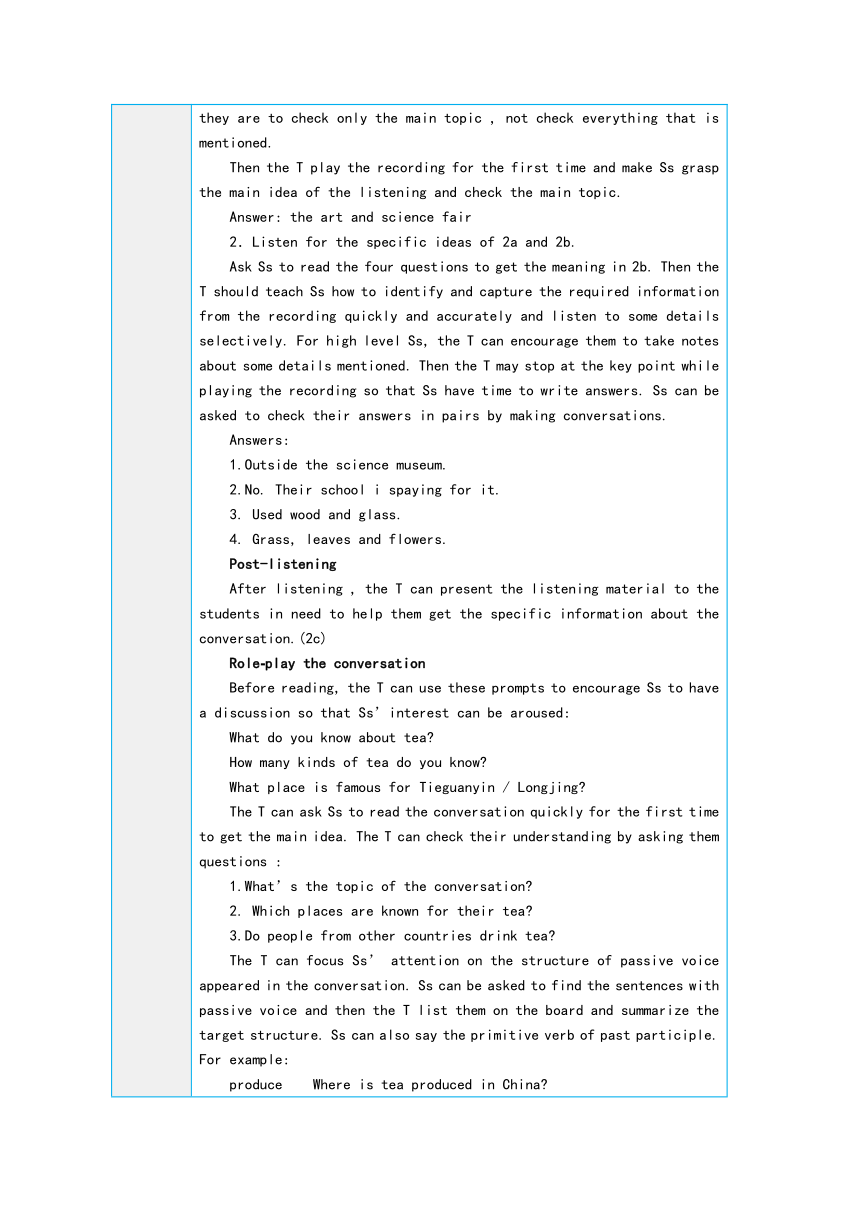Unit 5 What are the shirts made of? 第1课时 Section A(1a~2d)表格式教学设计
文档属性
| 名称 | Unit 5 What are the shirts made of? 第1课时 Section A(1a~2d)表格式教学设计 |  | |
| 格式 | docx | ||
| 文件大小 | 22.7KB | ||
| 资源类型 | 教案 | ||
| 版本资源 | 人教新目标(Go for it)版 | ||
| 科目 | 英语 | ||
| 更新时间 | 2024-05-31 06:55:12 | ||
图片预览



文档简介
人教版九年级英语(全)册
《Unit 5 What are the shirts made of 》
课时内容 第1课时 Section A (1a~2d)
教学目标 【知识与技能】 能掌握下列词汇: chopsticks, coin, fork, blouse, silver, glass, cotton, steel, grass, leaf, produce, widely, be known for, process, pack 2.能掌握以下句型: (1) —This ring looks nice. Is it made of silver —Yes, and it was made in Thailand. (2) What is it made of/from (3) China is famous for tea, right (4) Where is tea produced in China 【情感、态度与价值观】 了解一些日常用品的制成材料,增加生活常识,养成良好的生活习惯;了解一些地方知名产品或传统艺术品的制作过程以及制作材料,培养学生的民族自豪感及爱国主义精神。
教学重点 1.学习并积累一些与日常用品的制成材料有关的词汇。 2.能够用英语描述及询问物品的制作材料。 3.正确理解被动语态的用法及句子结构。
教学难点 理解被动语态的用法及句子结构。
教学准备 多媒体课件或其他教学所需的工具
教学过程
教学过程 Step 1: Leading in 1. 播放动画片《造纸过程》的视频,让学生们了解这个中国传统发明的情况。 T: Who invented paper first S1: Cai Lun invented it in Han dynasty. S2: It was mainly made of bamboo. T: was it easy for people to make paper then S1: No, it was very difficult then. T: What is paper made of now S3: It’s mainly made of wood, bamboo, and cotton. Step 2:Presentation Pre-listening Ask Ss to open their books and finish the task in 1a. The T can make Ss read the words in chorus and make sure they know the meanings of the words. Then Ss finish the task in 1a . The T can check answers by making conversations with Ss or asking them do this in pairs like this: T: What are chopsticks made of S1: They’re made of... S2: What is the window made of S3: It’s made of... Answers: 1.a,c 2.f 3.b.c 4.d 5.a,c 6.e While-listening While listening, the T can play the recording without stop for the first time and Ss finish the task in 1b. This step aims to develop Ss’ skills of grasping the target information. Then the T can play a second time to check Ss’ answers. This time, the T can stop at the key point and check Ss’ answers by asking them to say the complete the sentence, for example: The shirts are made of cotton. They were made in America. Answers: skirts—cotton—America chopsticks—steel—Korea ring—silver—Thailand Post-listening Ask Ss to look at the picture in 1a and make conversations following the example. (Tip: T can encourage Ss to talk freely or make conversations following the example in 1c.) Step 3:Work on 2a,2b,2c & 2d 1.Before listening , the T can ask Ss to look at the picture in 2a and talk about it. The T can use the following prompts: What’s this in the picture Where do you think we can see it in our daily life The T can ask Ss to read the expressions in 2a to make sure they get the meaning of them and the requirement of the task. The activity is to provide Ss with practice in listening for the main topic of a conversation. At the beginning, the T may emphasize to Ss that they are to check only the main topic , not check everything that is mentioned. Then the T play the recording for the first time and make Ss grasp the main idea of the listening and check the main topic. Answer: the art and science fair 2.Listen for the specific ideas of 2a and 2b. Ask Ss to read the four questions to get the meaning in 2b. Then the T should teach Ss how to identify and capture the required information from the recording quickly and accurately and listen to some details selectively. For high level Ss, the T can encourage them to take notes about some details mentioned. Then the T may stop at the key point while playing the recording so that Ss have time to write answers. Ss can be asked to check their answers in pairs by making conversations. Answers: 1.Outside the science museum. 2.No. Their school i spaying for it. 3. Used wood and glass. 4. Grass, leaves and flowers. Post-listening After listening , the T can present the listening material to the students in need to help them get the specific information about the conversation.(2c) Role play the conversation Before reading, the T can use these prompts to encourage Ss to have a discussion so that Ss’interest can be aroused: What do you know about tea How many kinds of tea do you know What place is famous for Tieguanyin / Longjing The T can ask Ss to read the conversation quickly for the first time to get the main idea. The T can check their understanding by asking them questions : 1.What’s the topic of the conversation 2. Which places are known for their tea 3.Do people from other countries drink tea The T can focus Ss’ attention on the structure of passive voice appeared in the conversation. Ss can be asked to find the sentences with passive voice and then the T list them on the board and summarize the target structure. Ss can also say the primitive verb of past participle. For example: produce Where is tea produced in China How is tea produced know Anxi and Hangzhou are widely known for their tea. ... .... Ask Ss to read the conversation again carefully and pay attention to the details .The T can ask some questions to check their understanding. 1. Which city is well-known for its tea 2. Where is tea grown 3. How are tea leaves picked 4. What needs to be done after tea leaves are processed 5. Why is tea drunk all over the world The T can play the recording of the conversation and make Ss read after it. Pay attention to the pronunciation and intonation. Then the T can play the video of the conversation and then invite some Ss to role-play the conversation as open pairs. Step 4: Language points 【知识讲解】 1.be made of,be made from与be made in (1)be made of 为“be+及物动词的过去分词+of”的被动语态结构,意为“由……制成”,指从原料到制成品只发生了形状变化,没有发生本质变化(属物理变化)。 (2)be made from意为“由……制成”,指从原料到制成品发生了质的变化,已无法复原(属化学变化)。 (3)be made in..意为“在……制造”,介词in后常接产地。 Glass is made of glass. 玻璃杯是由玻璃制成的。 The paper is made from wood. 纸是木头做的。 This kite is made in China.这个风筝是中国制造的。 2.fair (1)fair n. 展览会;交易会 (2)fair作形容词意为“公平的;公正的”, 常用结构:be fair to sb. 对某人是公平的,反义词为unfair 意为“不公平的;不公正的”,fair作形容词还可意为“白皙的;浅色的” 3.famous be famous for 意为“因……而出名”,后接原因(通常是名词) be famous as意为“作为……而出名”,后接表示身份、地位等的名词。 be famous to意为“为……所熟知”,后接表示人的名词。 Suzhou is known for its beautiful gardens. 苏州以其美丽的园林而闻名于世。 4.produce (1)produce v. 生产;制造;出产 (2)produce本身也可作名词,意为“产品; (尤指)农产品”。为不可数名词。区别于product。 ①product是produce的名词形式,意为“产品;成果”,是可数名词。 ②production也为produce的名词形式,意味“生产;产量”,是不可数名词。 (3)英语中有produce, grow和plant三个动词均可用来描述农作物及植物的“种植; 生产;生长”,但有所区别。 produce指农作物成产量化地“出产”,或自然地“生长出;长出;结出(果实)”。 This region produces over 50% of the country’s rice. 这个地区出产整个国家50%以上的大米。 These trees can produce very good apples. 这些树能结出优质的苹果。 grow表示“种植;使生长”,着重指种植以后的栽培、生长过程。 These plants grow from seeds. 这些植物从种子生长而来。 The villagers grow coffee and corn to sell in the market. 村民们种植咖啡和玉米好拿到市场上去卖。 plant侧重“栽种;播种”这一行为,指把种子或秧苗种到土壤里使之生长。 How many trees have you planted this year 今年你们种了多少棵树? They planted tomatoes and carrots in their backyard. 他们在后院栽种了西红柿和胡萝卜。 5.widely (1)widely adv. 广泛地;普遍地 由“wide(adj. 宽的)+ly(副词后缀)”构成相关词汇: (2)width n. 宽度;广度 widen v.(使)变宽; (使)扩大 Gas is widely used for cooking and heating. 天然气被广泛地用于做饭和取暖。 6.as far as I know as far as I know据我所知 结构类似的短语有: as far as I can see 依我看 As far as I can remember 据我所记得 as far as I can tell 据我所知 Step 5: Summary 建议:让学生自己总结本节课主要学习了什么,还有哪些疑惑?教师可作补充。
课堂作业 1.Preview the conversation in 2d. 2.Preview the passage in 3a. 3.Do the exercises in students’ book.
板书设计 Unit 5 What are the shirts made of Section A(1a~2d) (1)—Is it made of silver —Yes,and it was made in Thailand. (2)Well,as far as I know,tea plants are grown on the sides of mountains. (3)It seems that many people all over the world drink Chinese tea.
教学反思 1.这是单元的第一个课时,通过实物展示来教授新单词和复习学过的单词是一种有效的教学方法。一图胜千言,既能给学生更多的输入,又能激发学生的学习热情。在检查答案时,教师不必急于判断对错。他们应该让学生积极发言。这个环节是练习目标语言的好机会,尽量让各个层次的学生都有机会说。引导学生注意被动语态的构成。在这个阶段,可以暂时不加解释地理解句子,这样学生可以在语法感知阶段积累更多的感性知识。 2.被动语态对中国学生来说很难。他们要么忘记了动词“be”,要么遗漏了动词后面的“ed”,尤其是不规则动词的过去分词,这更容易让学生忘记。有时即使他们理解被动语态的意思,他们也没有什么应用意识。因此,教师必须为实践创造不同的语境。
《Unit 5 What are the shirts made of 》
课时内容 第1课时 Section A (1a~2d)
教学目标 【知识与技能】 能掌握下列词汇: chopsticks, coin, fork, blouse, silver, glass, cotton, steel, grass, leaf, produce, widely, be known for, process, pack 2.能掌握以下句型: (1) —This ring looks nice. Is it made of silver —Yes, and it was made in Thailand. (2) What is it made of/from (3) China is famous for tea, right (4) Where is tea produced in China 【情感、态度与价值观】 了解一些日常用品的制成材料,增加生活常识,养成良好的生活习惯;了解一些地方知名产品或传统艺术品的制作过程以及制作材料,培养学生的民族自豪感及爱国主义精神。
教学重点 1.学习并积累一些与日常用品的制成材料有关的词汇。 2.能够用英语描述及询问物品的制作材料。 3.正确理解被动语态的用法及句子结构。
教学难点 理解被动语态的用法及句子结构。
教学准备 多媒体课件或其他教学所需的工具
教学过程
教学过程 Step 1: Leading in 1. 播放动画片《造纸过程》的视频,让学生们了解这个中国传统发明的情况。 T: Who invented paper first S1: Cai Lun invented it in Han dynasty. S2: It was mainly made of bamboo. T: was it easy for people to make paper then S1: No, it was very difficult then. T: What is paper made of now S3: It’s mainly made of wood, bamboo, and cotton. Step 2:Presentation Pre-listening Ask Ss to open their books and finish the task in 1a. The T can make Ss read the words in chorus and make sure they know the meanings of the words. Then Ss finish the task in 1a . The T can check answers by making conversations with Ss or asking them do this in pairs like this: T: What are chopsticks made of S1: They’re made of... S2: What is the window made of S3: It’s made of... Answers: 1.a,c 2.f 3.b.c 4.d 5.a,c 6.e While-listening While listening, the T can play the recording without stop for the first time and Ss finish the task in 1b. This step aims to develop Ss’ skills of grasping the target information. Then the T can play a second time to check Ss’ answers. This time, the T can stop at the key point and check Ss’ answers by asking them to say the complete the sentence, for example: The shirts are made of cotton. They were made in America. Answers: skirts—cotton—America chopsticks—steel—Korea ring—silver—Thailand Post-listening Ask Ss to look at the picture in 1a and make conversations following the example. (Tip: T can encourage Ss to talk freely or make conversations following the example in 1c.) Step 3:Work on 2a,2b,2c & 2d 1.Before listening , the T can ask Ss to look at the picture in 2a and talk about it. The T can use the following prompts: What’s this in the picture Where do you think we can see it in our daily life The T can ask Ss to read the expressions in 2a to make sure they get the meaning of them and the requirement of the task. The activity is to provide Ss with practice in listening for the main topic of a conversation. At the beginning, the T may emphasize to Ss that they are to check only the main topic , not check everything that is mentioned. Then the T play the recording for the first time and make Ss grasp the main idea of the listening and check the main topic. Answer: the art and science fair 2.Listen for the specific ideas of 2a and 2b. Ask Ss to read the four questions to get the meaning in 2b. Then the T should teach Ss how to identify and capture the required information from the recording quickly and accurately and listen to some details selectively. For high level Ss, the T can encourage them to take notes about some details mentioned. Then the T may stop at the key point while playing the recording so that Ss have time to write answers. Ss can be asked to check their answers in pairs by making conversations. Answers: 1.Outside the science museum. 2.No. Their school i spaying for it. 3. Used wood and glass. 4. Grass, leaves and flowers. Post-listening After listening , the T can present the listening material to the students in need to help them get the specific information about the conversation.(2c) Role play the conversation Before reading, the T can use these prompts to encourage Ss to have a discussion so that Ss’interest can be aroused: What do you know about tea How many kinds of tea do you know What place is famous for Tieguanyin / Longjing The T can ask Ss to read the conversation quickly for the first time to get the main idea. The T can check their understanding by asking them questions : 1.What’s the topic of the conversation 2. Which places are known for their tea 3.Do people from other countries drink tea The T can focus Ss’ attention on the structure of passive voice appeared in the conversation. Ss can be asked to find the sentences with passive voice and then the T list them on the board and summarize the target structure. Ss can also say the primitive verb of past participle. For example: produce Where is tea produced in China How is tea produced know Anxi and Hangzhou are widely known for their tea. ... .... Ask Ss to read the conversation again carefully and pay attention to the details .The T can ask some questions to check their understanding. 1. Which city is well-known for its tea 2. Where is tea grown 3. How are tea leaves picked 4. What needs to be done after tea leaves are processed 5. Why is tea drunk all over the world The T can play the recording of the conversation and make Ss read after it. Pay attention to the pronunciation and intonation. Then the T can play the video of the conversation and then invite some Ss to role-play the conversation as open pairs. Step 4: Language points 【知识讲解】 1.be made of,be made from与be made in (1)be made of 为“be+及物动词的过去分词+of”的被动语态结构,意为“由……制成”,指从原料到制成品只发生了形状变化,没有发生本质变化(属物理变化)。 (2)be made from意为“由……制成”,指从原料到制成品发生了质的变化,已无法复原(属化学变化)。 (3)be made in..意为“在……制造”,介词in后常接产地。 Glass is made of glass. 玻璃杯是由玻璃制成的。 The paper is made from wood. 纸是木头做的。 This kite is made in China.这个风筝是中国制造的。 2.fair (1)fair n. 展览会;交易会 (2)fair作形容词意为“公平的;公正的”, 常用结构:be fair to sb. 对某人是公平的,反义词为unfair 意为“不公平的;不公正的”,fair作形容词还可意为“白皙的;浅色的” 3.famous be famous for 意为“因……而出名”,后接原因(通常是名词) be famous as意为“作为……而出名”,后接表示身份、地位等的名词。 be famous to意为“为……所熟知”,后接表示人的名词。 Suzhou is known for its beautiful gardens. 苏州以其美丽的园林而闻名于世。 4.produce (1)produce v. 生产;制造;出产 (2)produce本身也可作名词,意为“产品; (尤指)农产品”。为不可数名词。区别于product。 ①product是produce的名词形式,意为“产品;成果”,是可数名词。 ②production也为produce的名词形式,意味“生产;产量”,是不可数名词。 (3)英语中有produce, grow和plant三个动词均可用来描述农作物及植物的“种植; 生产;生长”,但有所区别。 produce指农作物成产量化地“出产”,或自然地“生长出;长出;结出(果实)”。 This region produces over 50% of the country’s rice. 这个地区出产整个国家50%以上的大米。 These trees can produce very good apples. 这些树能结出优质的苹果。 grow表示“种植;使生长”,着重指种植以后的栽培、生长过程。 These plants grow from seeds. 这些植物从种子生长而来。 The villagers grow coffee and corn to sell in the market. 村民们种植咖啡和玉米好拿到市场上去卖。 plant侧重“栽种;播种”这一行为,指把种子或秧苗种到土壤里使之生长。 How many trees have you planted this year 今年你们种了多少棵树? They planted tomatoes and carrots in their backyard. 他们在后院栽种了西红柿和胡萝卜。 5.widely (1)widely adv. 广泛地;普遍地 由“wide(adj. 宽的)+ly(副词后缀)”构成相关词汇: (2)width n. 宽度;广度 widen v.(使)变宽; (使)扩大 Gas is widely used for cooking and heating. 天然气被广泛地用于做饭和取暖。 6.as far as I know as far as I know据我所知 结构类似的短语有: as far as I can see 依我看 As far as I can remember 据我所记得 as far as I can tell 据我所知 Step 5: Summary 建议:让学生自己总结本节课主要学习了什么,还有哪些疑惑?教师可作补充。
课堂作业 1.Preview the conversation in 2d. 2.Preview the passage in 3a. 3.Do the exercises in students’ book.
板书设计 Unit 5 What are the shirts made of Section A(1a~2d) (1)—Is it made of silver —Yes,and it was made in Thailand. (2)Well,as far as I know,tea plants are grown on the sides of mountains. (3)It seems that many people all over the world drink Chinese tea.
教学反思 1.这是单元的第一个课时,通过实物展示来教授新单词和复习学过的单词是一种有效的教学方法。一图胜千言,既能给学生更多的输入,又能激发学生的学习热情。在检查答案时,教师不必急于判断对错。他们应该让学生积极发言。这个环节是练习目标语言的好机会,尽量让各个层次的学生都有机会说。引导学生注意被动语态的构成。在这个阶段,可以暂时不加解释地理解句子,这样学生可以在语法感知阶段积累更多的感性知识。 2.被动语态对中国学生来说很难。他们要么忘记了动词“be”,要么遗漏了动词后面的“ed”,尤其是不规则动词的过去分词,这更容易让学生忘记。有时即使他们理解被动语态的意思,他们也没有什么应用意识。因此,教师必须为实践创造不同的语境。
同课章节目录
- Unit 1 How can we become good learners.
- Section A
- Section B
- Unit 2 I think that mooncakes are delicious!
- Section A
- Section B
- Unit 3 Could you please tell me where the restroom
- Section A
- Section B
- Unit 4 I used to be afraid of the dark.
- Section A
- Section B
- Unit 5 What are the shirts made of?
- Section A
- Section B
- Review of Units 1-5
- Unit 6 When was it invented?
- Section A
- Section B
- Unit 7 Teenagers should be allowed to choose their
- Section A
- Section B
- Unit 8 It must belong to Carla.
- Section A
- Section B
- Unit 9 I like music that I can dance to.
- Section A
- Section B
- Unit 10 You're supposed to shake hands.
- Section A
- Section B
- Review of Units 6-10
- Unit 11 Sad movies make me cry.
- Section A
- Section B
- Unit 12 Life is full of the unexpected
- Section A
- Section B
- Unit 13 We're trying to save the earth!
- Section A
- Section B
- Unit 14 I remember meeting all of you in Grade 7.
- Section A
- Section B
- Review of Units 11-14
